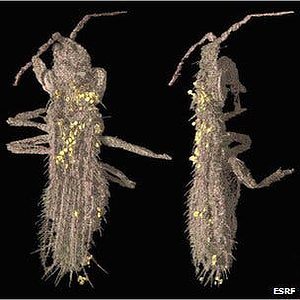
Scientists have uncovered pieces of fossilized amber containing tiny female insects called thrips, which upon closer inspections were found to have particles of pollen dusted over them. The insects found are around 100 million years old, officially making them the oldest pollination record ever found.
During the lower Cretaceous Period, which corresponds to the recently discovered fossilized thrips, the world’s flowering plants had just started to diversify, eventually coming to replace conifers as the dominant species.
“This is the oldest direct evidence for pollination, and the only one from the age of the dinosaurs,” study researcher Carmen Soriano said in a statement. “The co-evolution of flowering plants and insects, thanks to pollination, is a great evolutionary success story.”
The amber samples containing the insects were obtained from a site in northern Spain, and were subsequently imaged using the synchrotron at the European Synchrotron Radiation Facility (ESRF) in Grenoble, France. This revealed two new species of thrips, which they named Gymnospollisthrips major and G. minor.
The insects are very tiny, just 2 millimeters long, especially considering that during their time absolutely everything was big, like the giant fleas ten times the size of their modern counterparts. Also, the imaging took a closer look at the hundreds of pollen grains found on the surface of the insects, which either cam from a cycad or ginkgo tree, the researchers claim.
“Thrips might indeed turn out to be one of the first pollinator groups in geological history, long before evolution turned some of them into flower pollinators,” Soriano said.
The findings were reported in the journal PNAS.
Was this helpful?



